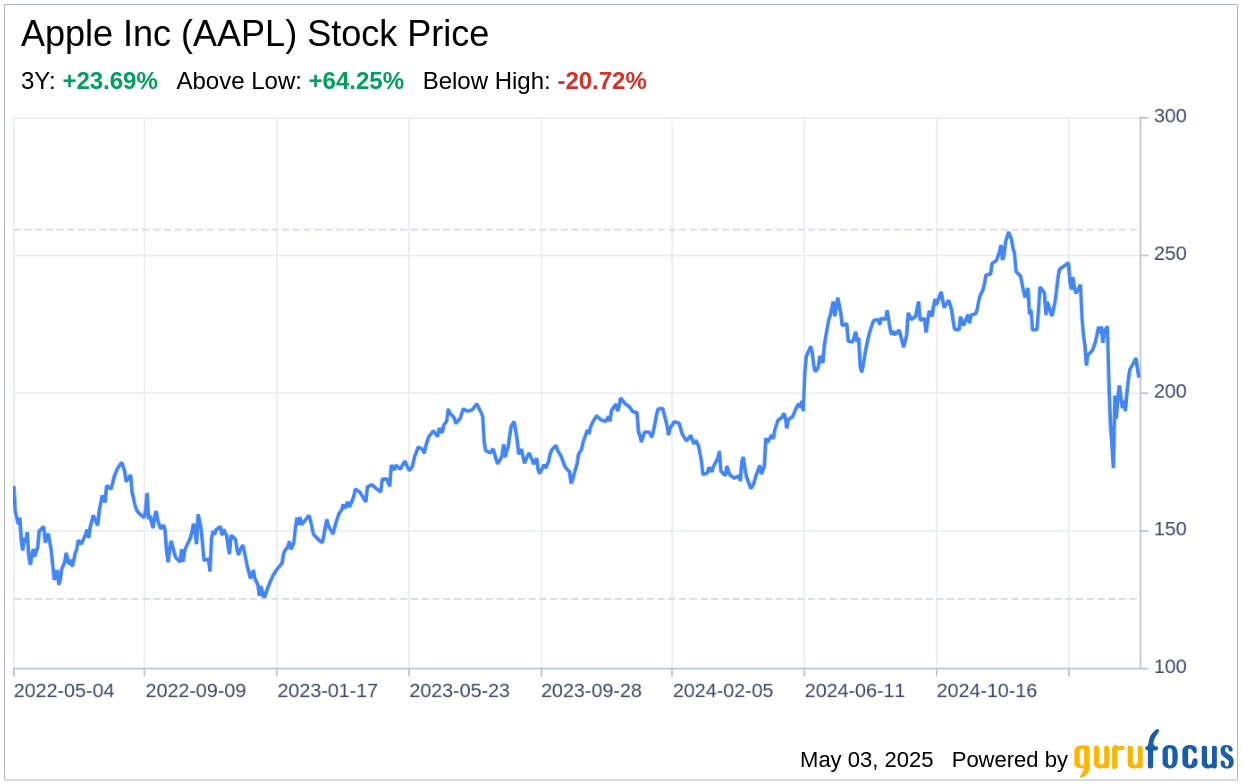On May 2, 2025, Apple Inc (AAPL, Financial) filed its 10-Q report, offering a glimpse into its financial performance and strategic positioning. The company reported a net income of $24,780 million for the three months ended March 29, 2025, an increase from $23,636 million in the prior year. Total net sales for the same period were $95,359 million, up from $90,753 million, driven by growth in both products and services. Apple's gross margin also improved, indicating effective cost management and a strong value proposition. These financial metrics reflect Apple's robust business model and its ability to innovate and adapt in a dynamic market environment.

Strengths
Brand Equity and Customer Loyalty: Apple Inc's brand is one of its most significant assets, consistently ranked as one of the most valuable brands globally. The company's ability to maintain a premium brand image allows it to command higher prices for its products, contributing to its impressive gross margin of $44,867 million for the three months ended March 29, 2025. Apple's loyal customer base is evidenced by its continued revenue growth, with a notable increase in services net sales from $23,867 million to $26,645 million in the same period. This loyalty not only drives repeat purchases but also facilitates cross-selling opportunities within Apple's ecosystem.
Innovation and R&D Investment: Apple's commitment to innovation is evident in its substantial R&D expenditure, which totaled $8,550 million for the three months ended March 29, 2025. This investment fuels the development of cutting-edge products and services, ensuring Apple remains at the forefront of technology. The launch of new products like the iPhone 16e and updated versions of the iPad Air, MacBook Air, and Mac Studio exemplifies Apple's dedication to product innovation, which is crucial for sustaining its competitive edge and driving future revenue growth.
Weaknesses
Dependence on Key Products: Despite a diverse product lineup, Apple Inc remains heavily reliant on its flagship product, the iPhone, which constitutes a significant portion of its net sales. This dependence exposes the company to risks associated with product lifecycle and consumer preferences. Any missteps in the design, functionality, or marketing of new iPhone models could have a disproportionate impact on Apple's overall financial performance and market position.
Supply Chain Concentration: Apple's supply chain is highly concentrated, with significant manufacturing operations outsourced to partners primarily located in Asia. As disclosed in the 10-Q filing, two vendors accounted for 49% and 19% of total vendor non-trade receivables as of March 29, 2025. This concentration increases vulnerability to geopolitical tensions, trade disputes, and other disruptions, which could lead to supply shortages, increased costs, and production delays, ultimately affecting Apple's ability to meet consumer demand and maintain its profit margins.
Opportunities
Services Expansion: The growth of Apple's services segment presents a significant opportunity for revenue diversification and margin expansion. With a $2,778 million increase in services net sales over the previous year, Apple can leverage its vast user base to promote subscription-based models and digital content offerings. This shift towards services not only provides recurring revenue streams but also enhances customer engagement and retention within the Apple ecosystem.
Emerging Technologies: Apple's R&D efforts position it to capitalize on emerging technologies such as augmented reality (AR) and artificial intelligence (AI). By integrating these technologies into its products and services, Apple can create differentiated experiences for consumers and open new revenue channels. The company's focus on innovation also aligns with broader industry trends, positioning Apple to lead in the development and adoption of future tech advancements.
Threats
Macroeconomic Conditions and Trade Tensions: Apple's international operations are susceptible to macroeconomic conditions, including inflation, interest rates, and currency fluctuations. The recent imposition of new tariffs and trade measures, as mentioned in the 10-Q filing, could lead to increased costs and supply chain disruptions. Apple's significant exposure to global markets also means that geopolitical tensions and retaliatory trade measures could materially impact its business operations and financial results.
Legal and Regulatory Challenges: Apple faces ongoing legal proceedings and regulatory scrutiny, as evidenced by the EU Digital Markets Act investigations and the U.S. Department of Justice lawsuit. These challenges could result in fines, changes to business practices, or reputational harm. The evolving regulatory landscape, particularly concerning antitrust and data privacy, requires Apple to navigate complex legal environments, which could affect its operational flexibility and strategic initiatives.
In conclusion, Apple Inc (AAPL, Financial) demonstrates a robust financial performance with a strong brand presence, innovative product offerings, and a growing services segment. However, the company must navigate challenges such as product concentration risks, supply chain vulnerabilities, and an uncertain global trade environment. Apple's continued investment in R&D and strategic focus on emerging technologies present opportunities for growth and differentiation. As Apple adapts to legal and regulatory pressures, it must balance innovation with compliance to maintain its market leadership and drive long-term shareholder value.
This article, generated by GuruFocus, is designed to provide general insights and is not tailored financial advice. Our commentary is rooted in historical data and analyst projections, utilizing an impartial methodology, and is not intended to serve as specific investment guidance. It does not formulate a recommendation to purchase or divest any stock and does not consider individual investment objectives or financial circumstances. Our objective is to deliver long-term, fundamental data-driven analysis. Be aware that our analysis might not incorporate the most recent, price-sensitive company announcements or qualitative information. GuruFocus holds no position in the stocks mentioned herein.
